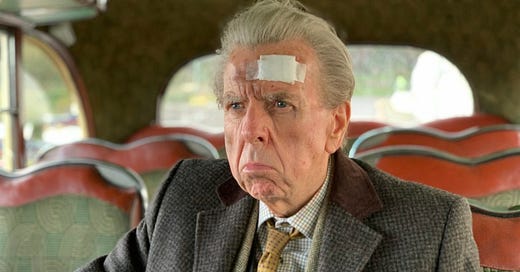The Last Bus
Timothy Spall gives a career-defining performance as an elderly man making one last bus-hopping trip across the breadth of the U.K.
“How old are you, granddad?”
“…VERY.”
This question comes not from Tom Harper’s actual grandson — the term “granddad” apparently being applied liberally in the United Kingdom to any older man. It seems intended somewhere between insult and affection, acknowledged someone’s status of accumulating years without necessary attaching any of the respect it deserves.
And it has a special, painful meaning for Tom personally.
Timothy Spall plays Tom, a British gent who has lived on the northernmost tip of Scotland for 50 years, and is now making a bus-hopping trip to the opposite end of the main English island. He is recently a widower, making this mysterious journey for unknown purposes, other than he is very insistent that it be completed.
It’s a career-changing turn by Spall, thrumming with melancholy power and quiet grace.
Tom is using the free bus pass given to retired Brits, jumping from local route to route rather than a single cross-country jaunt, indicating he’s not a man of great means. Indeed, somewhere during the trip we learn he was a simple mechanic, living in a tidy little home in John o' Groats, Scotland with his wife, Mary (Phyllis Logan). They had lived in Land’s End in Cornwall at the start of their marriage, but left soon after at Mary’s urging.
(God, I love Anglo names for stuff.)
Though sentiment also plays a part in his choice of conveyance. Tom, who must be over 90 as he served in World War II as a teen stretcher bearer, is actually retracing the steps of the trip he and Mary made a half-century earlier as a young couple, carrying just a few suitcases. When possible he stays in the same B&Bs or visits the same pubs they stopped at before.
The film flashes back to this time, with Natalie Mitson and Ben Ewing playing them as youngsters, they going north as old Tom heads south. He will often imagine seeing them on his trip, waiting by the side of the road or walking along the street he just passed, liked ghosts accompanying him as sacred custodians of his memory.
You may think a movie that is just 90 minutes of an old man riding on buses, saying very little and having various small encounters with others does not seem very interesting. Anything but.
The film, directed by Gillies MacKinnon from an original screenplay by Joe Ainsworth, is overtly sentimental but never maudlin, evoking an elegiac tone of man facing staggering loss. Tom looks back on a long life not with regret, but appreciation for the things he had leavened with deep sadness now that they are gone, or going.
A few things “happen” to Tom along the way, though it’s less a coherent plot than episodic experiences that serve to evoke different recollections and thoughts from his life. He carries only a small case, which is nearly stolen at one point. He stands up for a Muslim woman being accosted by a young prig, joins in a drunken singalong, has a stumbling fall and is taken in for the night by a nice middle-aged couple, and so on.
What Tom doesn’t know is that many of these moments are being captured on video and shared through social media, so as time goes on he is garnering something akin to fame.
It’s not difficult to detect similarities to other movies: “Nomadland” and “The World’s Fastest Indian” are two that immediately come to mind, since they involve journeys that are as much about the main character’s interior movement as where they’re going. But if the notes are familiar, “The Last Bus” assembles them into a unique and evocative melody that never feels like mimicry.
I should note that Spall is decades younger than the character he plays, and does not make use of any extensive prosthetics or special effects to do so. But he admirably captures the gait and disposition of a man much older — the stiff-legged way he walks, carefully setting down each foot in fear of slipping, turning his whole torso around rather than just his neck to look off to the side, and the vague fogs of confusion he occasionally wanders into, striving hard to maintain his dignity and avoid the appearance of doddering.
Tom’s default mien is vaguely peevish, brow lowered with his lower lip and jaw slung forward like a locomotive cowcatcher. But the emotive transformations that take place on his face are even more transportive than the physical journey he is bent upon. Spall brings a lifetime of thespian skill to bear, bringing us to the edge of tears or joyous laughter with a simple, subtle glance or twist of his cheek.
In so eloquently capturing the culminating journey of one man’s lifetime, Spall gives the performance of his own.





